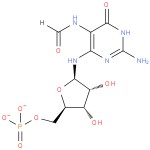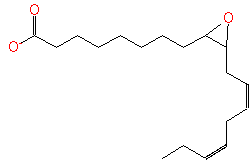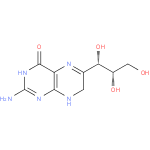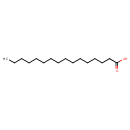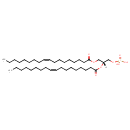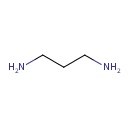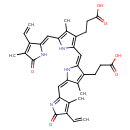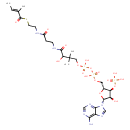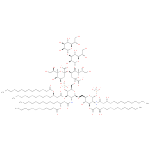
Search Results for compounds
Searching compounds for
returned 4373 results.
Displaying compounds 4211 - 4220 of
4373 in total
2-amino-5-formylamino-6-(5-phospho-D-ribosylamino)pyrimidin-4(3H)-one (PAMDB120509)
IUPAC:
1- deoxy-
deoxy- 1-
1- [(2-
[(2- amino-
amino- 5-
5- formamido-
formamido- 6-
6- oxo-
oxo- 1,6-
1,6- dihydropyrimidin-
dihydropyrimidin- 4-
4- yl)amino]-
yl)amino]- β-
β- D-
D- ribofuranose 5-
ribofuranose 5- phosphate
phosphate
CAS: Not Available
Description: The dianion obtained by removal of the two acidic protons from the phosphate group of 2-amino-5-formylamino-6-(1-D-ribosylamino)pyrimidin-4(3H)-one 5'-phosphate.
(12Z,15Z)-9,10-epoxyoctadeca-12,15-dienoate (PAMDB120510)
IUPAC:
Not Available
CAS: Not Available
Description: Not Available
7,8-dihydromonapterin (PAMDB120511)
IUPAC:
2-amino-6-[(1S,2S)-1,2,3-trihydroxypropyl]-7,8-dihydropteridin-4(3H)-one
CAS: Not Available
Description: A dihydropterin that is monapterin dihydrogenated at positions 7 and 8.
palmitate (PAMDB120512)
IUPAC:
hexadecanoate
CAS: 57-10-3
Description: A long-chain fatty acid anion that is the conjugate base of hexadecanoic acid (palmitic acid); major species at pH 7.3.
1-18:1-2-18:1-phosphatidate (PAMDB120513)
IUPAC:
[(2R)-2,3-bis[(9Z)-octadec-9-enoyloxy]propoxy]phosphonic acid
CAS: 14268-17-8
Description: PA(18:1(9Z)/18:1(9Z)) is a phosphatidic acid. It is a glycerophospholipid in which a phosphate moiety occupies a glycerol substitution site. As is the case with diacylglycerols, phosphatidic acids can have many different combinations of fatty acids of varying lengths and saturation attached at the C-1 and C-2 positions. Fatty acids containing 16, 18 and 20 carbons are the most common. PA(18:1(9Z)/18:1(9Z)), in particular, consists of one chain of oleic acid at the C-1 position and one chain of oleic acid at the C-2 position. The oleic acid moiety is derived from vegetable oils, especially olive and canola oil, while the oleic acid moiety is derived from vegetable oils, especially olive and canola oil. Phosphatidic acids are quite rare but are extremely important as intermediates in the biosynthesis of triacylglycerols and phospholipids. Indeed, the concentration of phosphatidic acids is often over-estimated in tissues and biofluids as it can arise by inadvertent enzymatic hydrolysis during inappropriate storage or extraction conditions during analysis. The main biosynthetic route of phosphatidic acid in animal tissues involves sequential acylation of alpha-glycerophosphate by acyl-CoA derivatives of fatty acids. PAs are biologically active lipids that can stimulate a large range of responses in many different cell types, such as platelet aggregation, smooth muscle contraction, in vivo vasoactive effects, chemotaxis, expression of adhesion molecules, increased tight junction permeability of endothelial cells, induction of stress fibres, modulation of cardiac contractility, and many others. Diacylglycerols (DAGs) can be converted to PAs by DAG kinases and indirect evidence supports the notion that PAs alter the excitability of neurons. Phospholipase Ds (PLDs), which catalyze the conversion of glycerolphospholipids, particularly phosphatidylcholine, to PAs and the conversion of N-arachidonoyl-phosphatidylethanolamine (NAPE) to anandamide and PAs are activated by several inflammatory mediators including bradykinin, ATP and glutamate. PAs activate downstream signaling pathways such as PKCs and mitogen-activated protein kinases (MAPKs), which are linked to an increase in sensitivity of sensory neurons either during inflammation or in chronic pain models. Circumstantial evidence that PAs are converted to DAGs. (PMID: 12618218 , 16185776 ).
propane-1,3-diamine (PAMDB120514)
IUPAC:
propane-1,3-bis(aminium)
CAS: 109-76-2
Description: An alkane-α,ω-diammonium(2+) that is the dication of trimethylenediamine arising from protonation of both nitrogens.
biliverdin-IX-α (PAMDB120516)
IUPAC:
3-(2-{[(2Z,5E)-3-(2-carboxyethyl)-5-[(3-ethenyl-4-methyl-2-oxo-2H-pyrrol-5-yl)methylidene]-4-methyl-2,5-dihydro-1H-pyrrol-2-ylidene]methyl}-5-{[(2Z)-3-ethenyl-4-methyl-5-oxo-2,5-dihydro-1H-pyrrol-2-ylidene]methyl}-4-methyl-1H-pyrrol-3-yl)propanoic acid
CAS: 114-25-0
Description: Dicarboxylate anion of biliverdin; major species at pH 7.3.
(E)-2-methylcrotonoyl-CoA (PAMDB120517)
IUPAC:
3'- phosphoadenosine 5'-
phosphoadenosine 5'- {3-
{3- [(3R)-
[(3R)- 3-
3- hydroxy-
hydroxy- 2,2-
2,2- dimethyl-
dimethyl- 4-
4- ({3-
({3- [(2-
[(2- {[(2E)-
{[(2E)- 2-
2- methylbut-
methylbut- 2-
2- enoyl]sulfanyl}ethyl)amino]-
enoyl]sulfanyl}ethyl)amino]- 3-
3- oxopropyl}amino)-
oxopropyl}amino)- 4-
4- oxobutyl] dihydrogen diphosphate}
oxobutyl] dihydrogen diphosphate}
CAS: Not Available
Description: Not Available
(heptosyl)2-Kdo2-lipid A (PAMDB120518)
IUPAC:
Not Available
CAS: Not Available
Description: A lipid A oxoanion obtained via deprotonation of the carboxy and phosphate OH groups of L-α-D-Hep-(1→3)-L-α-D-Hep-(1→5)-[α-Kdo-(2→4)]-α-Kdo-(2→6)-lipid A; major species at pH 7.3.
ω, mono-trans,octa-cis-decaprenyl diphosphate (PAMDB120519)
IUPAC:
Not Available
CAS: Not Available
Description: For polyisoprenols and polyisoprenyl phosphates nomenclature, see Polyisoprenoids.
